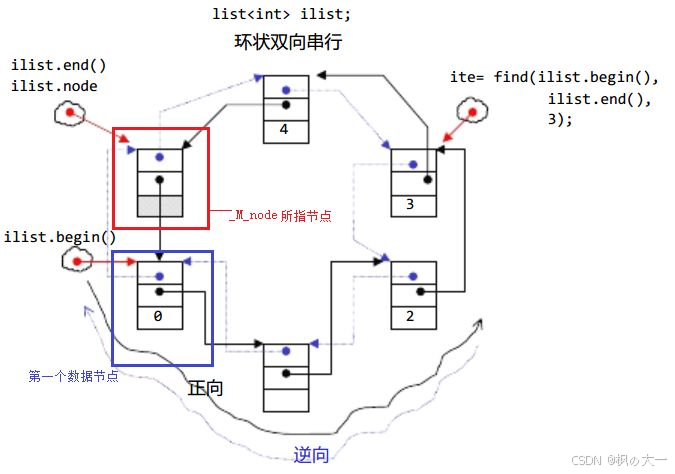

你不能改变过去,但你可以改变未来
算法/C++/数据结构/C
Hello,这里是小枫。C语言与数据结构和算法初阶两个板块都更新完毕,我们继续来学习C++的内容呀。C++是接近底层有比较经典的语言,因此学习起来注定枯燥无味,西游记大家都看过吧~,我希望能带着大家一起跨过九九八十一难,降伏各类难题,学会C++,我会尽我所能,以通俗易懂、幽默风趣的方式带给大家形象生动的知识,也希望大家遇到困难不退缩,遇到难题不放弃,学习师徒四人的精神!!!故此得名【C++游记】
话不多说,让我们一起进入今天的学习吧~~~
1>>List介绍

2>>List使用
2.1>>list构造
下面是一些用接口,大伙熟悉一下,后面模拟实现都会用到噢~
|----------------------------------------------------------|----------------------------|
| 构造函数( (constructor)) | 接口说明 |
| list (size_type n, const value_type& val =value_type()) | 构造的list中包含n个值为val的元素 |
| list() | 构造空的list |
| list (const list& x) | 拷贝构造函数 |
| list (InputIterator first, InputIterator last) | 用[first, last)区间中的元素构造lis |
2.2>>list iterator的使用
这个就是一个迭代器,可以想象为指向某个节点的指针。
|--------------|--------------------------------------------------------------------------------------------------------|
| 函数声明 | 接口说明 |
| begin + end | 返回第一个元素的迭代器+返回最后一个元素下一个位置的迭代器 |
| rbegin+ rend | 返回第一个元素的reverse_iterator,即end位置,返回最后一个元素下一个位 置的reverse_iterator,即begin位置(可以理解为rbegin就是end,rend就是begin) |
!!!
- begin与end为正向迭代器,对迭代器执行++操作,迭代器向后移动
- rbegin(end)与rend(begin)为反向迭代器,对迭代器执行++操作,迭代器向前移动
2.3>>迭代器失效
迭代器失效即迭代器所指向的节点的无效,即该节点被删除了。因为list的底层结构为带头结点的双向循环链表,因此在list中进行插入时是不会导致list的迭代器失效的,只有在删除时才会失效,并且失效的只是指向被删除节点的迭代器,其他迭代器不会受到影响。下面代码可供大伙练习,以get到失效的那个点。
cpp
void TestListIterator1()
{
int array[] = { 1, 2, 3, 4, 5, 6, 7, 8, 9, 0 };
list<int> l(array, array+sizeof(array)/sizeof(array[0]));
auto it = l.begin();
while (it != l.end())
{
// erase()函数执行后,it所指向的节点已被删除,因此it无效,在下一次使用it时,必须先给
其赋值
l.erase(it);
++it;
}
}
// 改正
void TestListIterator()
{
int array[] = { 1, 2, 3, 4, 5, 6, 7, 8, 9, 0 };
list<int> l(array, array+sizeof(array)/sizeof(array[0]));
auto it = l.begin();
while (it != l.end())
{
l.erase(it++); // it = l.erase(it);
}
}3>>list的模拟实现
经过上面的学习,我们了解到大部分list的使用了,接下来我会给大家两端代码,一个是list.h包含list的功能实现,还有test.cpp包含测试代码,list.h包含一些注释,有我自己和ai的注释,大家可以仿写,不会的欢迎评论区探讨。
3.1>>list.h
cpp
#pragma once
// 防止头文件被多次包含
namespace wc // 自定义命名空间,避免与标准库冲突
{
// 链表节点结构定义
template<class T>
struct list_node
{
T _data; // 节点存储的数据
list_node<T>* _next; // 指向后一个节点的指针
list_node<T>* _prev; // 指向前一个节点的指针
// 节点构造函数,默认参数为T的默认构造
list_node(const T& x = T())
:_data(x)
, _next(nullptr)
, _prev(nullptr)
{
}
};
// 链表迭代器实现(通过模板参数区分普通迭代器和const迭代器)
// T: 数据类型, Ref: 引用类型(T& 或 const T&), Ptr: 指针类型(T* 或 const T*)
template<class T, class Ref, class Ptr>
struct __list_iterator
{
typedef list_node<T> Node; // 节点类型重定义
typedef __list_iterator<T, Ref, Ptr> Self; // 迭代器自身类型重定义
Node* _node; // 指向当前节点的指针
// 迭代器构造函数
__list_iterator(Node* node)
:_node(node)
{
}
// 解引用操作符,返回节点数据的引用
Ref operator*()
{
return _node->_data;
}
// 箭头操作符,返回节点数据的指针
Ptr operator->()
{
return &_node->_data;
}
// 前置++,移动到下一个节点
Self& operator++()
{
_node = _node->_next;
return *this;
}
// 后置++,移动到下一个节点(返回原值)
Self operator++(int)
{
Self tmp(*this); // 保存当前状态
_node = _node->_next;
return tmp; // 返回未修改的临时对象
}
// 前置--,移动到前一个节点
Self& operator--()
{
_node = _node->_prev;
return *this;
}
// 后置--,移动到前一个节点(返回原值)
Self operator--(int)
{
Self tmp(*this); // 保存当前状态
_node = _node->_prev;
return tmp; // 返回未修改的临时对象
}
// 不等比较操作符
bool operator!=(const Self& it) const
{
return _node != it._node;
}
// 相等比较操作符
bool operator==(const Self& it) const
{
return _node == it._node;
}
};
/* 注释掉的const迭代器实现,已通过模板参数方式优化
template<class T>
struct __list_const_iterator
{
typedef list_node<T> Node;
Node* _node;
__list_const_iterator(Node* node)
:_node(node)
{}
const T& operator*()
{
return _node->_data;
}
__list_const_iterator<T>& operator++()
{
_node = _node->_next;
return *this;
}
__list_const_iterator<T> operator++(int)
{
__list_iterator<T> tmp(*this);
_node = _node->_next;
return tmp;
}
__list_const_iterator<T>& operator--()
{
_node = _node->_prev;
return *this;
}
__list_const_iterator<T> operator--(int)
{
__list_const_iterator<T> tmp(*this);
_node = _node->_prev;
return tmp;
}
bool operator!=(const __list_const_iterator<T>& it) const
{
return _node != it._node;
}
bool operator==(const __list_const_iterator<T>& it) const
{
return _node == it._node;
}
};*/
// 链表类定义
template<class T>
class list
{
typedef list_node<T> Node; // 节点类型重定义
public:
// 迭代器类型定义:普通迭代器和const迭代器
typedef __list_iterator<T, T&, T*> iterator;
typedef __list_iterator<T, const T&, const T*> const_iterator;
// 迭代器接口:返回第一个元素的迭代器
iterator begin()
{
return iterator(_head->_next); // 头节点的下一个是第一个元素
}
// 迭代器接口:返回尾后迭代器
iterator end()
{
return iterator(_head); // 头节点作为尾后标记
}
// const版本迭代器:返回第一个元素的const迭代器
const_iterator begin() const
{
return const_iterator(_head->_next);
}
// const版本迭代器:返回尾后const迭代器
const_iterator end() const
{
return const_iterator(_head);
}
// 初始化空链表(带头节点的双向循环链表)
void empty_init()
{
_head = new Node; // 创建头节点
_head->_next = _head; // 头节点的next指向自己
_head->_prev = _head; // 头节点的prev指向自己
}
// 默认构造函数
list()
{
empty_init();
}
// 拷贝构造函数
list(const list<T>& lt)
{
empty_init(); // 先初始化空链表
// 遍历源链表,将每个元素插入到新链表
for (const auto& e : lt)
{
push_back(e);
}
}
// 初始化列表构造函数,支持{1,2,3}形式初始化
list(initializer_list<T> il)
{
empty_init();
// 遍历初始化列表,插入元素
for (const auto& e : il)
{
push_back(e);
}
}
// 交换两个链表的内容
void swap(list<T>& lt)
{
std::swap(_head, lt._head); // 交换头节点指针
std::swap(_size, lt._size); // 交换大小
}
// 赋值运算符重载(现代写法,利用拷贝构造和交换)
list<T>& operator=(list<T> lt) // 传值参数会调用拷贝构造
{
swap(lt); // 与临时对象交换,出作用域后临时对象自动析构原数据
return *this;
}
/* 传统赋值运算符实现(已注释)
list<T>& operator=(const list<T>& lt)
{
if (this != <) // 防止自赋值
{
clear(); // 清空当前链表
// 拷贝元素
for (const auto& e : lt)
{
push_back(e);
}
}
return *this;
}*/
// 析构函数
~list()
{
clear(); // 清空所有元素节点
delete _head; // 删除头节点
_head = nullptr;
}
// 清空链表(保留头节点)
void clear()
{
iterator it = begin();
// 逐个删除节点直到链表为空
while (it != end())
{
it = erase(it); // erase返回下一个迭代器
}
}
// 尾插
void push_back(const T& x)
{
insert(end(), x); // 在尾后迭代器位置插入
}
// 头插
void push_front(const T& x)
{
insert(begin(), x); // 在第一个元素位置插入
}
// 尾删
void pop_back()
{
erase(--end()); // 删除最后一个元素
}
// 头删
void pop_front()
{
erase(begin()); // 删除第一个元素
}
// 在指定位置插入元素
iterator insert(iterator pos, const T& val)
{
Node* cur = pos._node; // 获取当前位置节点
Node* newnode = new Node(val);// 创建新节点
Node* prev = cur->_prev; // 获取当前节点的前一个节点
// 调整指针连接新节点
prev->_next = newnode;
newnode->_next = cur;
cur->_prev = newnode;
newnode->_prev = prev;
++_size; // 大小加1
return iterator(newnode); // 返回指向新节点的迭代器
}
// 删除指定位置的元素
iterator erase(iterator pos)
{
Node* cur = pos._node; // 获取当前节点
Node* prev = cur->_prev; // 前一个节点
Node* next = cur->_next; // 后一个节点
// 调整指针跳过当前节点
prev->_next = next;
next->_prev = prev;
delete cur; // 释放当前节点内存
--_size; // 大小减1
return iterator(next); // 返回指向后一个节点的迭代器
}
// 获取链表大小
size_t size() const
{
/* 遍历计数方式(已注释,改用_size成员变量)
size_t n = 0;
for (auto& e : *this)
{
++n;
}
return n;*/
return _size;
}
private:
Node* _head; // 头节点指针(哨兵节点)
size_t _size = 0; // 链表元素个数
};
}3.2>>test.cpp
cpp
#define _CRT_SECURE_NO_WARNINGS 1
#include<iostream>
#include<algorithm>
#include<vector>
#include<list>
using namespace std;
void test_list1()
{
list<int> lt1;
list<int> lt2(10, 1);
vector<int> v1 = { 1,2,3,4,5,6 };
list<int> lt3(v1.begin(), v1.end());
list<int> lt4 = { 1,2,3,4,5,6,1,1,1,1 };
int a[] = { 1,20,3,40 };
list<int> lt5(a, a + 4);
sort(a, a + 4);
// 1、封装,通用的相似的遍历容器的方式,并且封装屏蔽容器结构的差异,和底层实现细节
// 2、通用/复用,实现算法时用迭代器函数模板方式实现,跟底层容器结构解耦
list<int>::iterator it4 = lt4.begin();
while (it4 != lt4.end())
{
cout << *it4 << " ";
++it4;
}
cout << endl;
for (auto e : lt4)
{
cout << e << " ";
}
cout << endl;
sort(a, a + 4);
sort(v1.begin(), v1.end());
// 不能用,要求是随时迭代器
//sort(lt3.begin(), lt3.end());
reverse(lt3.begin(), lt3.end());
reverse(v1.begin(), v1.end());
}
void test_list2()
{
list<int> lt2(10, 1);
lt2.push_back(10);
lt2.push_front(10);
for (auto e : lt2)
{
cout << e << " ";
}
cout << endl;
lt2.resize(20, 2);
for (auto e : lt2)
{
cout << e << " ";
}
cout << endl;
lt2.resize(5);
for (auto e : lt2)
{
cout << e << " ";
}
cout << endl;
}
void test_list3()
{
std::list<double> first, second;
first.push_back(3.1);
first.push_back(2.2);
first.push_back(2.9);
second.push_back(3.7);
second.push_back(7.1);
second.push_back(1.4);
first.sort();
second.sort();
first.merge(second);
std::list<double> lt1 = { 1,2,3,4,5,6,2,3,2 };
lt1.remove(2);
for (auto e : lt1)
{
cout << e << " ";
}
cout << endl;
//
std::list<double> lt2 = { 1,2,3,4,5,6 };
for (auto e : lt2)
{
cout << e << " ";
}
cout << endl;
// 把5转移到头部位置
auto it = find(lt2.begin(), lt2.end(), 5);
lt2.splice(lt2.begin(), lt2, it);
for (auto e : lt2)
{
cout << e << " ";
}
cout << endl;
}
void test_op1()
{
srand(time(0));
const int N = 100000;
list<int> lt1;
vector<int> v;
for (int i = 0; i < N; ++i)
{
auto e = rand() + i;
lt1.push_back(e);
v.push_back(e);
}
int begin1 = clock();
// 排序
sort(v.begin(), v.end());
int end1 = clock();
int begin2 = clock();
lt1.sort();
int end2 = clock();
printf("vector sort:%d\n", end1 - begin1);
printf("list sort:%d\n", end2 - begin2);
}
void test_op2()
{
srand(time(0));
const int N = 1000000;
list<int> lt1;
list<int> lt2;
for (int i = 0; i < N; ++i)
{
auto e = rand() + i;
lt1.push_back(e);
lt2.push_back(e);
}
int begin1 = clock();
// 拷贝vector
vector<int> v(lt2.begin(), lt2.end());
// 排序
sort(v.begin(), v.end());
// 拷贝回lt2
lt2.assign(v.begin(), v.end());
int end1 = clock();
int begin2 = clock();
lt1.sort();
int end2 = clock();
printf("list copy vector sort copy list sort:%d\n", end1 - begin1);
printf("list sort:%d\n", end2 - begin2);
}
#include"list.h"
namespace wc
{
void test_list1()
{
wc::list<int> lt;
lt.push_back(1);
lt.push_back(2);
lt.push_back(3);
lt.push_back(4);
list<int>::iterator it = lt.begin();
while (it != lt.end())
{
cout << *it << " ";
++it;
}
cout << endl;
}
template<class T>
void print(const list<T>& lt)
{
// 类模板未实例化,不能去类模板中找后面的东西
// 编译器就分不清const_iterator是嵌套内类,还是静态成员变量
// typename告诉编译器,我确认过了这里是类型
//typename list<T>::const_iterator it = lt.begin();
auto it = lt.begin();
while (it != lt.end())
{
//*it += 1;
cout << *it << " ";
++it;
}
cout << endl;
}
void test_list2()
{
wc::list<int> lt1;
lt1.push_back(1);
lt1.push_back(2);
lt1.push_back(3);
lt1.push_back(4);
list<int>::iterator it = lt1.begin();
while (it != lt1.end())
{
*it += 1;
cout << *it << " ";
++it;
}
cout << endl;
print(lt1);
}
struct Pos
{
int _row;
int _col;
Pos(int row = 0, int col = 0)
:_row(row)
, _col(col)
{
}
};
void test_list3()
{
std::list<Pos> lt1;
lt1.push_back({ 1,1 });
lt1.push_back({ 2,2 });
lt1.push_back({ 3,3 });
lt1.push_back({ 4,4 });
//list<Pos>::iterator it = lt1.begin();
auto it = lt1.begin();
while (it != lt1.end())
{
//cout << (*it)._row << ":" << (*it)._col << endl;
// 为了可读性,这里省略了一个->
cout << it->_row << ":" << it->_col << endl;
//cout << it.operator->()->_row << ":" << it.operator->()->_col << endl;
++it;
}
cout << endl;
}
void test_list4()
{
wc::list<int> lt1;
lt1.push_back(1);
lt1.push_back(2);
lt1.push_back(3);
lt1.push_back(4);
print(lt1);
lt1.push_front(10);
lt1.push_front(20);
print(lt1);
lt1.pop_back();
lt1.pop_back();
print(lt1);
lt1.pop_front();
lt1.pop_front();
print(lt1);
}
void test_list5()
{
wc::list<int> lt1;
lt1.push_back(1);
lt1.push_back(2);
lt1.push_back(3);
lt1.push_back(4);
print(lt1);
wc::list<int> lt2 = lt1;
print(lt1);
wc::list<int> lt3 = { 10,20,30,40 };
lt1 = lt3;
print(lt1);
}
void test_list6()
{
wc::list<int> lt1 = { 10,20,30,40 };
print(lt1);
wc::list<double> lt2 = { 10.1,20.1,30.1,40.1 };
print(lt2);
}
}
int main()
{
wc::test_list6();
//test_op2();
//
//cout<<typeid(vector<int>::iterator).name() << endl;
return 0;
}4>>list和vector的对比
|-----------|----------------------------------------------------------------------|-------------------------------------------|
| | vector | list |
| 底 层 结 构 | 动态顺序表,一段连续空间 | 带头结点的双向循环链表 |
| 随 机 访 问 | 支持随机访问,访问某个元素效率O(1) | 不支持随机访问,访问某个元 素效率O(N) |
| 插 入 和 删 除 | 任意位置插入和删除效率低,需要搬移元素,时间复杂度为O(N),插入时有可能需要增容,增容:开辟新空间,拷贝元素,释放旧空间,导致效率更低 | 任意位置插入和删除效率高,不需要搬移元素,时间复杂度为O(1) |
| 空 间 利 用 率 | 底层为连续空间,不容易造成内存碎片,空间利用 率高,缓存利用率高 | 底层节点动态开辟,小节点容 易造成内存碎片,空间利用率 低,缓存利用率低 |
| 迭 代 器 | 原生态指针 | 对原生态指针(节点指针)进行 封装 |
| 迭 代 器 失 效 | 在插入元素时,要给所有的迭代器重新赋值,因为插入元素有可能会导致重新扩容,致使原来迭代器失效,删除时,当前迭代器需要重新赋值否则会失效 | 插入元素不会导致迭代器失效,删除元素时,只会导致当前迭代器失效,其他迭代器不受影响 |
| 使 用 场 景 | 需要高效存储,支持随机访问,不关心插入删除效率 | 大量插入和删除操作,不关心 随机访问 |
5>>结语
今日C++到这里就结束啦,如果觉得文章还不错的话,可以三连支持一下。感兴趣的宝子们欢迎持续订阅小枫,小枫在这里谢谢宝子们啦~小枫の主页还有更多生动有趣的文章,欢迎宝子们去点评鸭~C++的学习很陡,时而巨难时而巨简单,希望宝子们和小枫一起坚持下去~你们的三连就是小枫的动力,感谢支持~
